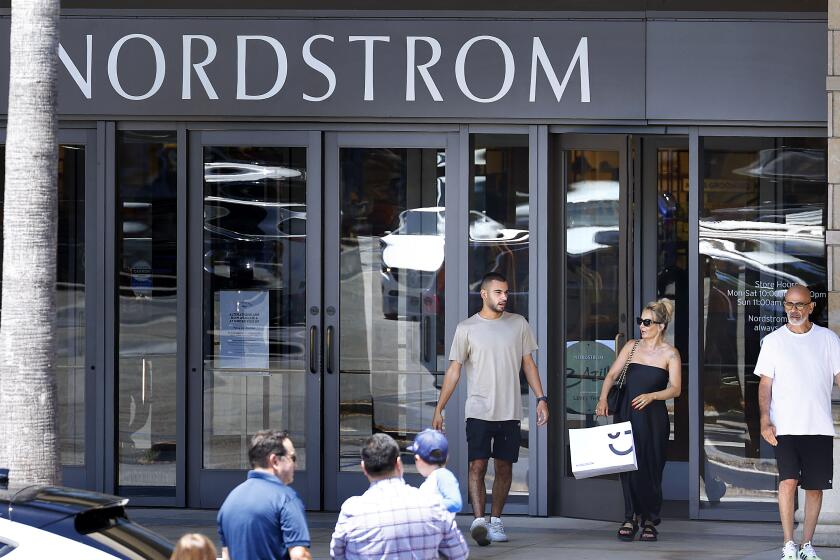Fed Trims Key Interest Rates
- Share via
WASHINGTON — Faced with worrisome signs of a sinking economy, the Federal Reserve Board on Wednesday pushed down interest rates for the second time in two months in a preemptive strike against the next recession.
The move--which is designed to ripple through the nation’s economic landscape in the form of lower consumer costs for everything from autos to houses--reduced key short-term rates by one-quarter of a percentage point.
More significantly, Wednesday’s action was widely seen as a signal that Fed Chairman Alan Greenspan and the rest of the policy-setting Federal Open Market Committee have embarked on a path of further rate cuts in the near future.
Reaction was immediate. Major banks, led by Chase Manhattan, began to lower their prime lending rates for consumers and business by one-quarter of a point. The Clinton administration and its critics spun out carefully crafted statements in response to the Fed’s action. And Wall Street--the scene of a feverish rally earlier this week in anticipation of falling rates--rallied a bit more.
The Dow Jones industrial average finished Wednesday with a gain of 13.73, following its 76.23-point jump the day before. Bonds also gained.
“The Fed is concerned about a slowdown,” Sung Won Sohn, chief economist at Norwest Corp. in Minneapolis, said in explaining Wednesday’s move. “It’s not becoming a recession yet, but clearly the risks are on the down side.”
In a one-page statement, the Fed said that it was reducing its highly influential federal funds rate--which banks charge each other for overnight loans--to 5.25% from 5.5%. Officials also said they were lowering the discount rate, which the Fed charges on its own loans to banks, to 5% from 5.25%--a symbolic gesture that will have limited effect on the economy.
Almost instantly, Chase Manhattan Corp. and First Chicago NBD Corp. said they would lower their prime rates to 8.25% from 8.5%. The move quickly spread as Bank of America, Citibank and others made identical announcements. The prime is a benchmark rate set by banks for a variety of loans to consumers and business.
For all the signs of a softer economy, however, some oddsmakers believed that the political calendar was key to the decision, which came after a two-day meeting of the Fed’s policymaking committee in Washington. That is because 1996 is an election year, and it is easier for the Fed to act sooner rather than later to preserve the appearance of impartiality.
“It wasn’t a real shock,” said Hugh Johnson, chief investment officer at First Albany Corp., a New York-based brokerage firm.
The Fed action--which amounts to a declaration that the U.S. economy needs help--came a week after President Clinton proclaimed in his State of the Union address that “our economy is the healthiest it has been in three decades.”
While it is possible for a fundamentally healthy economy to slip into a temporary downturn, administration officials Wednesday seemed aware that the public might be confused by the set of contradictory messages. Clinton would like to point to a strong economy--featuring robust job gains--as one of his administration’s key accomplishments as he campaigns for reelection.
“We believe the economy will remain healthy in 1996,” said a statement issued by White House Press Secretary Mike McCurry after the Fed announcement.
Two of the administration’s top economic officials also jumped into the fray.
“Although growth rates always vary quarter to quarter . . . we believe that the economy will remain healthy in 1996,” said Treasury Secretary Robert E. Rubin and Joseph E. Stiglitz, chairman of the White House Council of Economic Advisors.
For their part, Republicans were quick to seize the Fed action as evidence of White House mismanagement of the economy.
“The reason our economy is struggling and incomes have stagnated is a result of high tax, heavy regulation and big government spending that have characterized the Clinton administration,” said Sen. Connie Mack (R-Fla.), chairman of the Senate Joint Economic Committee.
Despite ongoing problems, California lately has exhibited greater strength than the national economy by some measures. And analysts said that the Fed’s moves could pay off in an above-average boost for the Golden State.
“California tends to be more interest-sensitive than the U.S. as a whole,” explained Gary Schlossberg, an economist with Wells Fargo Bank in San Francisco, alluding to the high cost of housing and the monthly burden that home loans exert on many Californians. A trend toward lower interest rates, he said, would yield greater-than-average savings to Californians, through mortgage refinancings and cheaper home loans.
The Fed’s target, however, was the national economy, which has slowed significantly in recent months--raising fears that the expansion that began in the spring of 1991 is withering. Earlier this week, for example, the government reported meager gains in retail sales during the holiday season. And the Conference Board, a business research group, announced that consumer confidence had fallen to the lowest level in two years.
It also was reported Wednesday that wholesale prices jumped by 0.5% in December--matching the unexpected increase in November. Economists blamed the unusual increases on temporary winter-related energy costs, rather than a sustained outbreak of inflation.
In deciding to lower rates, the Fed clearly had a similar interpretation, although recent government shutdowns denied it some of the basic information that ordinarily would have been available in making Wednesday’s decision.
“The Fed’s action will begin to correct the vicious cycle of slow growth in employment and incomes and anemic consumer demand,” said Jerry Jasinowski, president of the National Assn. of Manufacturers. “With a soft economy showing no signs of inflation, lower interest rates are essential to boost economic growth, create more jobs and improve the living standard for workers.”
Many attribute the U.S. economy’s weakness to the Fed itself, which moved aggressively to raise interest rates in 1994, a time when concerns centered on a new outbreak of inflation and overheated growth. Interest-rate moves affect the economy with a pronounced time lag that some forecasters believe may last longer than a year.
Now, in battling against a slowdown, economists say the Fed could be on track to lower the federal funds rate at least to 5% and perhaps as low as 4.5% by midyear.
“We look for multiple rounds of easing in coming months,” said economists at the Merrill Lynch investment firm, predicting that the rate would be pushed down to 4.5% by July.
More to Read
Inside the business of entertainment
The Wide Shot brings you news, analysis and insights on everything from streaming wars to production — and what it all means for the future.
You may occasionally receive promotional content from the Los Angeles Times.









